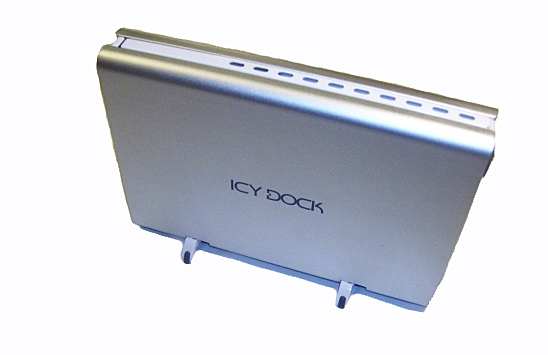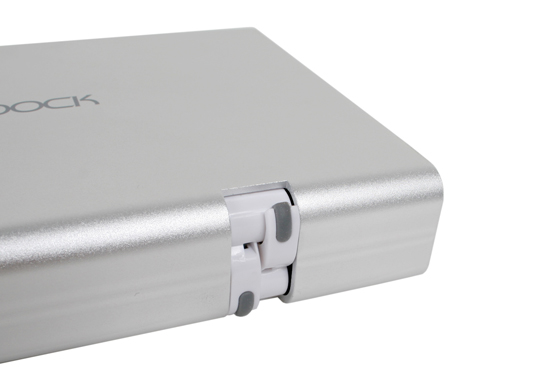ICY DOCK MB664US-1S: eSATA with a twist
by Dave Robinet on October 9, 2007 1:00 PM EST- Posted in
- Storage
ICY DOCK MB664US-1S
The ICY DOCK MB664US-1S is a relatively small, single-drive enclosure comprised of aluminum and plastic. Remaining true to ICY DOCK's unspoken product mantra of "attractive, but not flashy" hardware, the unassuming MB664US-1S has a brushed silver outer shell, with the modest ICY DOCK logo. The middle of the enclosure is ringed by a white strip, providing drive access, ventilation, and the external ports. The front panel is plastic, while all other outwardly facing surfaces are metal.

The ICY DOCK MB664 has no active cooling solution, instead relying on the aluminum exterior shell and a small series of ventilation holes along one side of the enclosure to dissipate the heat emitted by modern hard drives.


Rather than providing a snap-in stand for the MB664US, ICY DOCK has come up with a clever open/close scissor configuration. With the mount in the closed position, the unit can rest on its side, with the edge of the pad protruding only a couple of millimeters from the main shell. With the mounts opened, the unit stands on its side, seated on small rubber feet. Drive cooling proved to be slightly better with the unit resting on its side in the "open scissor" configuration, though no issues were encountered in either configuration.

As previously mentioned, the MB664US-1S is configured to support both USB2.0 and eSATA drives. Interestingly, ICY DOCK has chosen to include a security cable slot on the MB664US line of enclosures, providing a basic level of security for users. A power switch and connector are the only other items on the MB664's back panel.
The most interesting feature of the MB664US-1S is its "tool-less" design. The front of the enclosure has a lock/unlock switch and a push button which provides access to the slide-in caddy for hard drive installation.

No tools are required to mount (or dismount) the hard drive, and there is no detachable drive caddy to worry about at all. This proved to be a mixed blessing, however, as drive installation and removal did take a little bit of practice before things went smoothly. While it is unclear that a user would ever have a need to open the front of the enclosure during drive operation, this was nevertheless an impossible task, as the drive eject arm is part of the same mechanism as the front panel cover.
The backplane itself is minimal (as in the MB559US), and is held in by four screws. ICY DOCK does provide a single LED in the front of the enclosure to indicate drive operation status, though the LED has only a pinhole cutout in the front panel, limiting the effectiveness of the LED somewhat.
The word "PUSH" shown in the drive pictures is actually a sticker, and can be removed with ease (and without leaving residue on the front panel). It was left on to show the means to open the enclosure, as there is otherwise no indication on the unit.

True to form for ICY DOCK, the included accessory kit has everything required to operate the drive either in USB or eSATA mode, including both external cables. For users who want additional flexibility, ICY DOCK offers a "Hybrid" bracket housing both an external SATA connector (converting from an internal SATA port) as well as a connector going from an internal 4-pin Molex plug to the external power adapter required by the enclosure. This gives the user the ability to either power the enclosure using their internal PC power supply, or using the standard power brick included in the packaging. Please note that this bracket is sold separately, and is not included in the base package (as was originally written in this space - our apologies for the error).
As we noted in our earlier review of the ICY DOCK MB559US, proper chipset support of eSATA is strongly recommended in order to use this enclosure with the internal-external SATA connector adapter. Modern SATA chipsets should be fine, but exercise caution particularly with early VIA chipsets or the Intel ICH6.
| ICY DOCK MB664US-1S Specifications | |
| Host Interface | eSATA + USB 2.0 Combination |
| Drive Type | 3.5" SATA 1.5Gb/s or 3Gb/s Interface |
| Drive Position | Vertical or Horizontal |
| Transfer Rates | Up to 3Gb/s per eSATA specs Up to 480Mb/s per USB 2.0 specs |
| Connection Type | SATA |
| Structure Type | Aluminum Body with Plastic Trim |
| Drive Cooling | Passive via Aluminum frame heat dispersion with ventilation ports |
| Activity Indicators | Device Power and Drive Activity via LED |
| OS Support | Windows 98/SE/ME/2000/XP/Vista, Mac OS 9.0 or higher |
| Power Draw | 2W |
| Dimensions (LxWxH) | 194 x 142.6 x 42.6 mm |
| Weight | 1.10 lbs. |
The ICY DOCK MB664US-1S is a relatively small, single-drive enclosure comprised of aluminum and plastic. Remaining true to ICY DOCK's unspoken product mantra of "attractive, but not flashy" hardware, the unassuming MB664US-1S has a brushed silver outer shell, with the modest ICY DOCK logo. The middle of the enclosure is ringed by a white strip, providing drive access, ventilation, and the external ports. The front panel is plastic, while all other outwardly facing surfaces are metal.

The ICY DOCK MB664 has no active cooling solution, instead relying on the aluminum exterior shell and a small series of ventilation holes along one side of the enclosure to dissipate the heat emitted by modern hard drives.


Rather than providing a snap-in stand for the MB664US, ICY DOCK has come up with a clever open/close scissor configuration. With the mount in the closed position, the unit can rest on its side, with the edge of the pad protruding only a couple of millimeters from the main shell. With the mounts opened, the unit stands on its side, seated on small rubber feet. Drive cooling proved to be slightly better with the unit resting on its side in the "open scissor" configuration, though no issues were encountered in either configuration.

As previously mentioned, the MB664US-1S is configured to support both USB2.0 and eSATA drives. Interestingly, ICY DOCK has chosen to include a security cable slot on the MB664US line of enclosures, providing a basic level of security for users. A power switch and connector are the only other items on the MB664's back panel.
The most interesting feature of the MB664US-1S is its "tool-less" design. The front of the enclosure has a lock/unlock switch and a push button which provides access to the slide-in caddy for hard drive installation.

No tools are required to mount (or dismount) the hard drive, and there is no detachable drive caddy to worry about at all. This proved to be a mixed blessing, however, as drive installation and removal did take a little bit of practice before things went smoothly. While it is unclear that a user would ever have a need to open the front of the enclosure during drive operation, this was nevertheless an impossible task, as the drive eject arm is part of the same mechanism as the front panel cover.
The backplane itself is minimal (as in the MB559US), and is held in by four screws. ICY DOCK does provide a single LED in the front of the enclosure to indicate drive operation status, though the LED has only a pinhole cutout in the front panel, limiting the effectiveness of the LED somewhat.
The word "PUSH" shown in the drive pictures is actually a sticker, and can be removed with ease (and without leaving residue on the front panel). It was left on to show the means to open the enclosure, as there is otherwise no indication on the unit.

True to form for ICY DOCK, the included accessory kit has everything required to operate the drive either in USB or eSATA mode, including both external cables. For users who want additional flexibility, ICY DOCK offers a "Hybrid" bracket housing both an external SATA connector (converting from an internal SATA port) as well as a connector going from an internal 4-pin Molex plug to the external power adapter required by the enclosure. This gives the user the ability to either power the enclosure using their internal PC power supply, or using the standard power brick included in the packaging. Please note that this bracket is sold separately, and is not included in the base package (as was originally written in this space - our apologies for the error).
As we noted in our earlier review of the ICY DOCK MB559US, proper chipset support of eSATA is strongly recommended in order to use this enclosure with the internal-external SATA connector adapter. Modern SATA chipsets should be fine, but exercise caution particularly with early VIA chipsets or the Intel ICH6.










19 Comments
View All Comments
Homerboy - Wednesday, October 10, 2007 - link
ntSeanFL - Wednesday, October 10, 2007 - link
one complaint I have about the 559 is that the drive is always on...even if my machine is off. It would be much nicer if the drive could spin down after a pre-set adjustable time for people like me that just use it to back up each day/week, etc. Other external drives can do that.Anyone know if this new enclosure does it any differently?
floflooo - Thursday, October 11, 2007 - link
Please give me some references... I've been looking for external HDD cases that have power management.icthy - Wednesday, October 10, 2007 - link
I'm not an expert as you can see....I'm looking for a way to use my 3 ATA 133 drives; can I get an enclosure such as the Icy Dock that will deal with these?retrospooty - Wednesday, October 10, 2007 - link
There are enclosures out there that use the ATA 133 interface, but not eSATA onces. You will be able to find USB 2.0 and Firewire enclosures, just search for them.http://www.google.com/search?hl=en&rlz=1B3GGGL...">http://www.google.com/search?hl=en&...ternal+d...
icthy - Wednesday, October 10, 2007 - link
Thanks. Guess I should have figured that out myself.DigitalFreak - Wednesday, October 10, 2007 - link
Um, what's the twist?StraightPipe - Tuesday, October 9, 2007 - link
Well obviously, $70 is bad. Many decent enclosures start around $15-20.The PC power option is good. I keep an e-sata drive on my HTPC (it feels fast like it's in the box instead of on a wire). It would be great if the enclosure was powered by the PC (like this icydock). That way I could keep the USB and wall plug in a bag together for when I take the drive to a friend's PC. I can leave my PC connections on top of the PC case, and take the drive and it's cable bag to go.
pnyffeler - Tuesday, October 9, 2007 - link
How would a Raptor perform in this case?Would it be too hot, given the lack of active cooling?
StraightPipe - Tuesday, October 9, 2007 - link
Raptors peform about the same as that samsung they tested in the article.As drive densities have increased the transfer rates have too.
My raptor is no hotter than my 500GB WD RE2 drives in RAID0. I would assume temp is not a problem in normal (70-80F ambient) conditions.
The fact is for the price of a 150GB raptor you can get a 500-750GB drive that performs almost as well. Now that there are better performing drives available, those raptors just are not worth the cost anymore.